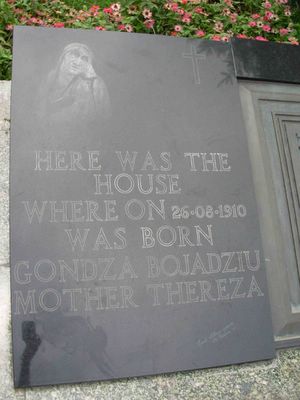Bashino Selo: August 2nd is called Ilinden and is an important holiday here. There was a big battle in Kruchevo, back in 1903 against the ruling Ottoman (Turkish) empire, where the Macedonians won and created their own Republic, which held for 10 days before Turkish reinforcements came in and destroyed the republic. The revolutionaries (Nikola Karev, Goce Delchev, Pitu Guli) are memorialized all over the country. For the holiday, I went to visit my host family in Bashino Selo. The village people go up to a nearby hill where there is a cross, a priest comes and leads a short service, food and clothing and people are blessed and then everyone eats lots of yummy homemade food.
Priest blessing


My extended host family in Bashino Selo


Tetovo: I went to Tetovo (west of Skopje) to visit my friends Keith and Megan who took care of my kitten Miloyka while I was gone. During that time they fell in love with her and asked if I might consider letting them keep her. It was a hard decision, but in the end I decided they could adopt her. Miloyka was alone for long periods of time and plus I already have a cat back in Seattle. Tetovo is a big city with a sizable population of Albanians. Unfortunately there is still some tension between Macedonians and Albanians as there was a war between them in 2001. Walking around town in some ways felt like being in a different country, there is so much more diversity in the western part of the country. Turks and Albanians (and Muslim) men wear caps on their heads, Muslim women cover their heads with scarves and sometimes wear dresses that look like cloaks, that go all the way to the ground. There are also a number of Mosques there. I visited one that is famous called “The Painted Mosque”, built in the 16th century. Up close the exterior looks like large, brightly colored playing cards! It also has a nice garden
The Painted Mosque


The Albanian Flag, Wedding Procession


Skopje: I did some sightseeing in the capital city, which I hadn’t done before, even though I’ve been to Skopje many times. Usually I’m there for Peace Corps business, so I haven’t done much else. This time I visited “Kale” (pronounced “Kah-lay”), which is a fortress up on the hill above the city. My guidebook says that this Ottoman fortress and the River Vardar Valley may have had human settlements from as early on as Neolithic times (3500BC)! A Byzantine town was believed to have been built on this location between 700-500BC. The fortress that is seen today was constructed probably during the Medieval period, between 9th-14th century. There is very little information at the site, but interesting to walk around, and has great views of the city below. I also saw evidence of some damage, which I suspect was from the devastating earthquake in 1963. I also visited the site of the house where Mother Teresa was born, which is now just a plaque next to a busy shopping center in downtown Skopje. Mother Teresa was Albanian, although born in Macedonia (1910).
Ancient and Modern Skopje


Downtown Skopje


Mother Teresa


Mother Teresa's House Was Here


Prelip: a large city south of Veles, in the south-central part of the country also has a lot of history, as it is just next to the Towers of Marko, which is another medieval fortress built on the top of a very large hill overlooking the city. Archeological evidence has been found here that date back to the 3rd & 4th centuries BC. The fortress was built about the same time as Kale in Skopje, with the purpose of keeping out the Turks (which wasn’t successful given that the Turks ruled Macedonia for 500 years--until early 1900’s). But there were a lot of battles fought in this region, and even though the fortress is in ruins, it is still interesting and gives a great view of the large city below. In the center of town is the old Turkish center, with a large pedestrian area and the wall of an old Turkish bath still remains. There are also the ruins of a Muslim mosque destroyed in 2001 during the conflict with the Albanians.
Downtown Prelip, Statue of Alexander III with Towers in the Background


Marko's Fortress


View of Prelip from the Towers


Soon it’s back to work for me, first day of school is Sept 1st!
No comments:
Post a Comment